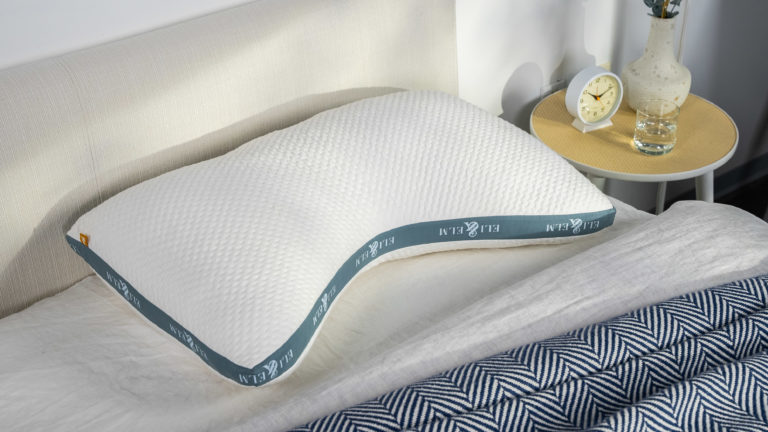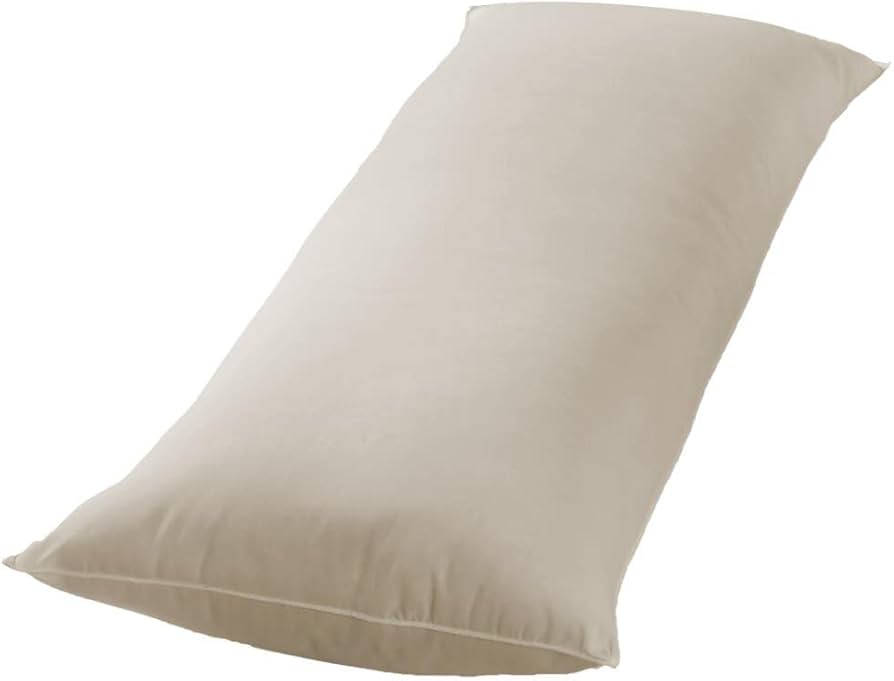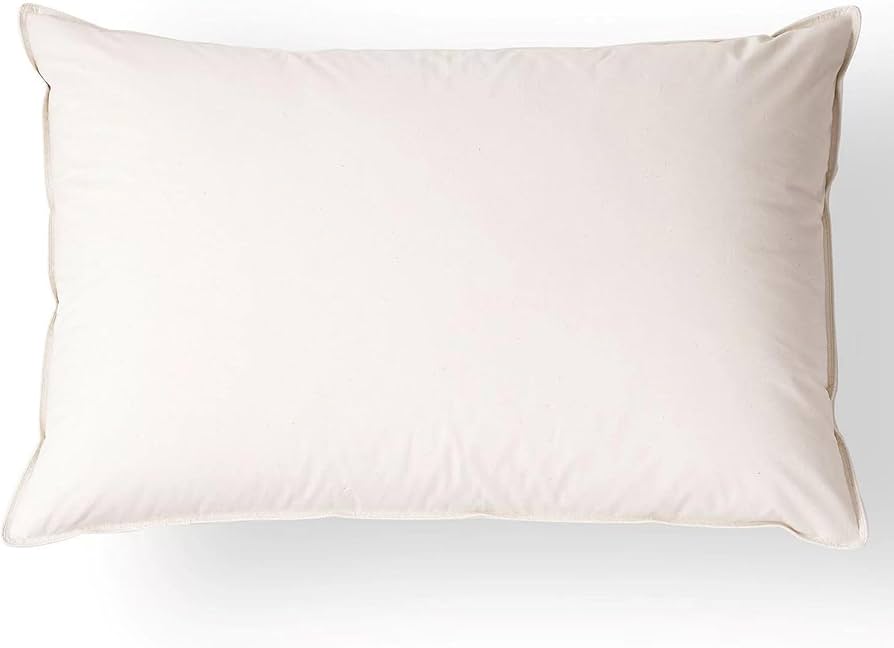Yes, wool pillows can help alleviate neck pain. They offer unique benefits that may improve sleep quality and reduce discomfort.
Neck pain can significantly impact your daily life, making it hard to sleep or concentrate. Choosing the right pillow is crucial for minimizing this pain. Wool pillows are known for their natural properties and comfort. They provide good support, helping to maintain proper neck alignment.
This can reduce strain and tension in your neck muscles. Additionally, wool is breathable and regulates temperature well, ensuring a comfortable sleep environment. In this blog post, we will explore why wool pillows might be a good option for those suffering from neck pain. We will look at their benefits, how they compare to other pillow types, and what to consider when choosing one.
Wool Pillow Basics
Neck pain can be a persistent issue that affects sleep quality and daily life. Choosing the right pillow is crucial for alleviating this discomfort. Wool pillows are gaining popularity for their unique benefits. Let’s explore the basics of wool pillows and how they might help with neck pain.
To Get The Best Pillow For Neck Pain – Visit Our Shop
Material Properties
Wool pillows are made from natural wool fibers, which offer several unique properties beneficial for neck pain sufferers.
Breathability: Wool is highly breathable. It allows air to circulate, keeping you cool in summer and warm in winter.
Moisture-Wicking: Wool can absorb moisture without feeling wet. It helps maintain a dry sleep environment, reducing the risk of mold and mildew.
Hypoallergenic: Wool is naturally resistant to dust mites and bacteria, making it suitable for allergy sufferers.
Support: Wool fibers are resilient and provide gentle support. They conform to the shape of your neck and head, offering customized support.
Here’s a table summarizing these properties:
| Property | Description |
| Breathability | Keeps you cool or warm, depending on the season |
| Moisture-Wicking | Absorbs moisture, maintaining a dry sleep environment |
| Hypoallergenic | Resistant to dust mites and bacteria |
| Support | Conforms to the shape of your neck and head |
Manufacturing Process
The manufacturing process of wool pillows involves several steps to ensure quality and comfort.
Shearing: Wool is harvested from sheep through shearing, which is a humane and necessary process.
Cleaning: The wool undergoes thorough cleaning to remove dirt, lanolin, and other impurities. This step ensures the wool is safe and clean for use.
Carding: The cleaned wool is carded. This process separates and aligns the fibers, making them soft and fluffy.
Filling: The carded wool is then filled into pillowcases. Manufacturers ensure an even distribution of wool for consistent support.
Finishing: The pillows are finished with a quality cover, often made from natural cotton, to enhance breathability and comfort.
These steps ensure that the final product is supportive, comfortable, and durable.
In summary, the properties of wool and the careful manufacturing process make wool pillows a great option for those dealing with neck pain.

Neck Pain Factors
Neck pain is a common issue that affects many people. Finding the right pillow can significantly alleviate this discomfort. Wool pillows are gaining popularity for their comfort and support. Understanding the factors that contribute to neck pain can help determine if wool pillows are a good choice.
To Get The Best Pillow For Neck Pain – Visit Our Shop
Common Causes
Neck pain can arise from various factors, some of which are related to lifestyle, while others may be due to underlying health conditions.
Here are some common causes of neck pain:
- Poor Posture: Sitting or standing with incorrect posture can strain neck muscles.
- Sleeping Position: An awkward sleeping position can lead to neck stiffness.
- Injury: Accidents or falls can result in neck injuries.
- Stress: High stress levels can cause muscle tension in the neck.
- Medical Conditions: Conditions like arthritis or herniated discs can lead to chronic neck pain.
These factors contribute to neck pain by causing muscle strain, nerve compression, or joint issues.
Understanding these causes can help in choosing the right pillow. A pillow that offers proper support and alignment can alleviate neck pain significantly.
Impact On Sleep
Neck pain can greatly impact the quality of sleep. Good sleep is essential for overall health and well-being.
Here’s how neck pain affects sleep:
- Discomfort: Persistent neck pain can make it difficult to find a comfortable sleeping position.
- Frequent Waking: Pain can cause frequent waking during the night, leading to interrupted sleep.
- Poor Sleep Quality: Inability to sleep well affects the restorative quality of sleep.
- Fatigue: Lack of proper sleep can lead to daytime fatigue and reduced productivity.
Using a supportive pillow like a wool pillow can help in reducing neck pain during sleep. Wool pillows provide natural support and adjust to the shape of your neck. This helps in maintaining proper alignment and reducing discomfort.
Choosing the right pillow can make a significant difference in sleep quality. Wool pillows can offer the necessary support and comfort, leading to better sleep and reduced neck pain.
To Get The Best Pillow For Neck Pain – Visit Our Shop
Benefits Of Wool
Many people suffer from neck pain and are looking for the best pillow to alleviate their discomfort. Wool pillows are an excellent choice for those seeking relief. One of the main reasons is the various benefits that wool offers. Let’s explore some of these benefits to understand why wool pillows might be a good option for neck pain sufferers.
Temperature Regulation
One significant advantage of wool is its natural ability to regulate temperature. Sleeping comfortably requires a balanced temperature. Wool pillows help in maintaining this balance. Unlike synthetic materials, wool adapts to your body temperature. It keeps you warm during cold nights and cool during hot nights.
Here are some key points on how wool helps with temperature regulation:
- Natural Insulation: Wool fibers trap air, providing excellent insulation. This keeps you warm when it’s chilly.
- Breathability: Wool allows air to circulate, preventing overheating. This breathability helps keep your neck at a comfortable temperature.
- Adaptability: Wool adjusts to changes in temperature, ensuring a consistent sleep environment. This adaptability can help reduce neck pain caused by temperature fluctuations.
The following table compares wool to other common pillow materials in terms of temperature regulation:
| Material | Temperature Regulation |
| Wool | Excellent |
| Synthetic | Poor |
| Cotton | Moderate |
Moisture Wicking
Another benefit of wool is its moisture-wicking properties. Wool can absorb moisture without feeling damp. This is crucial for maintaining a dry and comfortable sleeping environment.
Here are some points on how wool’s moisture-wicking abilities can help with neck pain:
- Absorption: Wool can absorb up to 30% of its weight in moisture. This helps keep your pillow dry and comfortable.
- Evaporation: Wool releases moisture into the air. This process helps keep the pillow dry, reducing the risk of mold and mildew.
- Hygiene: A dry pillow is less likely to harbor bacteria and dust mites, which can aggravate neck pain.
The following table highlights the moisture-wicking capabilities of different pillow materials:
| Material | Moisture Wicking |
| Wool | Excellent |
| Synthetic | Poor |
| Cotton | Moderate |
Wool Vs. Other Materials
When dealing with neck pain, finding the right pillow can make a big difference. Wool pillows are often considered, but how do they compare to pillows made from other materials? Let’s dive into a comparative analysis and explore allergy considerations.
Comparative Analysis
Wool pillows offer unique benefits compared to other types of pillows. Here’s a breakdown:
- Support: Wool pillows provide good support for the neck. They conform to the shape of your neck and head.
- Temperature Regulation: Wool naturally regulates temperature. It keeps you cool in the summer and warm in the winter.
- Durability: Wool pillows are long-lasting. They maintain their shape and support over time.
- Moisture Wicking: Wool absorbs moisture. This keeps your pillow dry and comfortable.
Now, let’s compare wool pillows with other popular pillow materials:
| Material | Support | Temperature Regulation | Durability | Moisture Wicking |
| Wool | High | Excellent | High | Excellent |
| Memory Foam | High | Poor | Medium | Poor |
| Feather/Down | Medium | Good | Low | Medium |
| Polyester | Low | Poor | Low | Poor |
Wool pillows stand out in several areas. They offer excellent support and temperature regulation. They are also durable and good at wicking moisture. Memory foam pillows provide similar support but fall short in temperature regulation and moisture wicking. Feather and down pillows are comfortable but lack durability. Polyester pillows are less supportive and durable.
Allergy Considerations
Wool pillows have several advantages for people with allergies. Here are some key points:
- Hypoallergenic: Wool is naturally hypoallergenic. It resists dust mites and mold.
- Breathable: Wool fibers allow air to circulate. This reduces the buildup of allergens.
- Moisture Control: Wool wicks away moisture. This helps prevent mold and mildew growth.
Comparing wool to other materials in terms of allergies:
| Material | Hypoallergenic | Resists Dust Mites | Breathability | Moisture Control |
| Wool | Yes | Yes | High | Excellent |
| Memory Foam | No | Yes | Low | Poor |
| Feather/Down | No | No | Medium | Medium |
| Polyester | Yes | No | Low | Poor |
Wool pillows are a great choice for allergy sufferers. They naturally resist dust mites and mold. They also have excellent breathability and moisture control. Memory foam pillows resist dust mites but lack breathability. Feather and down pillows can harbor dust mites. Polyester pillows are hypoallergenic but lack other benefits.
Support And Alignment
Are wool pillows good for neck pain? When it comes to sleep quality, support and alignment are key factors. Wool pillows can provide excellent support for the neck and spine. They help maintain proper alignment, reducing the risk of neck pain and discomfort. Let’s explore how wool pillows offer spinal support and posture improvement.
To Get The Best Pillow For Neck Pain – Visit Our Shop
Spinal Support
Wool pillows are known for their ability to offer superior spinal support. They conform to the natural curvature of your neck, ensuring that your spine remains in a neutral position throughout the night. This can be particularly beneficial for those who suffer from chronic neck pain.
Here are some key benefits of wool pillows for spinal support:
- Natural Conformity: Wool adapts to your body’s shape, providing personalized support.
- Firmness: Wool pillows offer a balance between softness and firmness, ideal for spinal alignment.
- Resilience: Wool retains its shape longer than synthetic materials, ensuring consistent support.
Let’s look at a comparison between wool pillows and other types:
| Type of Pillow | Spinal Support | Durability |
| Wool Pillow | Excellent | High |
| Memory Foam Pillow | Good | Medium |
| Feather Pillow | Moderate | Low |
Posture Improvement
Proper posture during sleep is crucial for overall health. Wool pillows can significantly improve your sleeping posture. They help maintain the correct alignment of the head, neck, and spine.
Benefits of wool pillows for posture improvement include:
- Enhanced Neck Alignment: Wool pillows keep the neck in a neutral position, reducing strain.
- Adaptive Support: The natural fibers adjust to your movements, providing continuous support.
- Temperature Regulation: Wool naturally regulates temperature, preventing discomfort that can disrupt posture.
Here’s a quick comparison of wool pillows with other materials in terms of posture support:
| Type of Pillow | Posture Support | Comfort Level |
| Wool Pillow | High | Comfortable |
| Memory Foam Pillow | Moderate | Comfortable |
| Feather Pillow | Low | Comfortable |
Using a wool pillow can lead to better sleep posture and reduced neck pain. It’s a simple change that can make a significant difference in your overall health.
User Experiences
Wool pillows have become popular for those seeking relief from neck pain. Many users have shared their experiences, highlighting the benefits and comfort provided by wool pillows. Let’s explore what users and experts have to say about wool pillows and their effectiveness in alleviating neck pain.
Testimonials
Many people have shared their positive experiences with wool pillows. Here are some of the most common feedback points:
- Comfort: Users often mention the softness and support provided by wool pillows. They find them more comfortable than synthetic alternatives.
- Temperature Regulation: Wool pillows help regulate temperature, keeping the head cool in the summer and warm in the winter.
- Hypoallergenic: People with allergies report fewer issues with wool pillows as they are naturally resistant to dust mites and mold.
Let’s look at some specific testimonials:
| User | Experience |
| Jane | Jane mentioned that her neck pain reduced significantly after switching to a wool pillow. She appreciates the consistent support it provides. |
| John | John said he sleeps better with a wool pillow. He no longer wakes up with a stiff neck and finds the pillow very comfortable. |
Expert Opinions
Experts in sleep and ergonomics have also weighed in on the benefits of wool pillows. Here are some insights from professionals:
- Support: Experts agree that wool pillows offer good support for the neck. The natural fibers conform to the shape of the neck and head, providing adequate support.
- Breathability: Wool pillows are breathable, which helps in maintaining a comfortable sleeping temperature. This can contribute to a better night’s sleep and less neck pain.
- Durability: Wool pillows are durable and maintain their shape over time. This ensures long-term support and comfort.
Here are some specific opinions from experts:
| Expert | Opinion |
| Dr. Smith | Dr. Smith emphasizes the importance of neck support during sleep. He recommends wool pillows for their ability to provide consistent support and comfort. |
| Dr. Lee | Dr. Lee highlights the hypoallergenic properties of wool pillows. He notes that they are a good choice for people with allergies, reducing the risk of allergic reactions. |
Care And Maintenance
Wool pillows are often recommended for those suffering from neck pain. They offer excellent support, are hypoallergenic, and regulate temperature well. However, to ensure they remain effective and comfortable, proper care and maintenance are essential. This guide will help you keep your wool pillow in top condition.
Cleaning Tips
Maintaining a clean wool pillow is crucial for both hygiene and longevity. Follow these tips to keep your pillow fresh:
- Spot Cleaning: Use a mild detergent and a damp cloth to clean any spots. Avoid soaking the pillow as wool fibers can become damaged.
- Air Drying: After cleaning, let the pillow air dry completely. Place it in a well-ventilated area, away from direct sunlight to prevent the wool from becoming brittle.
- Regular Fluffing: Fluff your wool pillow daily to maintain its shape and support. This prevents the wool from clumping and keeps it evenly distributed.
- Pillow Covers: Use a pillow cover to protect the pillow from dirt and oils. Wash the cover regularly to keep the pillow clean.
For a deeper clean, check the care label on your wool pillow. Some pillows may be machine washable, but always use a gentle cycle with cold water. Adding a few tennis balls to the dryer can help maintain the pillow’s shape.
Longevity Practices
To ensure your wool pillow remains supportive and comfortable for years, follow these longevity practices:
- Regular Rotation: Rotate your pillow every few months to ensure even wear. This helps maintain its shape and support.
- Proper Storage: If you need to store your wool pillow, keep it in a breathable bag, away from moisture and direct sunlight. Avoid plastic bags as they can trap moisture and cause mold.
- Support Maintenance: Regularly check your pillow for any signs of flattening. If it starts to lose its shape, you can rejuvenate it by gently pulling apart the wool fibers with your fingers.
- Environment Control: Keep your bedroom at a moderate temperature and humidity level. Extreme conditions can affect the wool’s natural properties.
By taking these steps, you can extend the life of your wool pillow, ensuring it continues to provide the support your neck needs. A well-maintained pillow not only helps with neck pain but also improves sleep quality.
Cost Considerations
When considering wool pillows for neck pain, cost is an important factor. Wool pillows have many benefits, but understanding the cost can help you decide if they are right for you. Let’s explore the price range and value for money of wool pillows.
Price Range
Wool pillows can vary in price based on brand, quality, and size. It’s important to know what you might expect to spend:
- Basic Wool Pillows: These can cost between $30 to $60. They offer good support but may have fewer features.
- Mid-Range Wool Pillows: Priced between $60 to $100. These typically have better quality wool and additional features like adjustable loft.
- Premium Wool Pillows: These high-end options can cost over $100. They often use organic wool and have luxury features.
For a clearer view, here is a table summarizing the price range:
| Type | Price Range |
| Basic Wool Pillows | $30 – $60 |
| Mid-Range Wool Pillows | $60 – $100 |
| Premium Wool Pillows | $100+ |
Understanding these price ranges helps you budget for a wool pillow that meets your needs and preferences.
Value For Money
When assessing value for money, it’s not just about the price tag. It’s about what you get in return. Wool pillows offer several benefits:
- Natural Material: Wool is a natural, sustainable resource.
- Temperature Regulation: Wool keeps you cool in summer and warm in winter.
- Hypoallergenic: Wool is resistant to dust mites, making it ideal for allergy sufferers.
- Durability: Wool pillows can last longer than synthetic ones.
Consider the long-term savings on health and comfort. A wool pillow can reduce neck pain, leading to better sleep quality. This can result in fewer medical expenses and improved overall well-being. Here’s a comparison to show the potential savings:
| Benefit | Synthetic Pillows | Wool Pillows |
| Material Cost | Low | Moderate |
| Temperature Regulation | Poor | Excellent |
| Hypoallergenic | Varies | High |
| Durability | 2-3 years | 5-7 years |
Overall, while wool pillows might have a higher initial cost, their benefits and longevity can provide greater value over time.
Final Thoughts
When considering options for neck pain relief, wool pillows often come up as a natural and supportive choice. Their unique properties offer a balance of comfort and support that can help alleviate discomfort. But are wool pillows the right solution for everyone? Let’s explore the final thoughts on this topic.
Who Should Choose Wool
Wool pillows are an excellent choice for many people due to their natural benefits. They are especially suitable for:
- Allergy Sufferers: Wool is hypoallergenic. It resists dust mites, mold, and bacteria, making it ideal for people with allergies.
- Hot Sleepers: Wool regulates temperature well. It keeps you cool in summer and warm in winter, ensuring a comfortable sleep year-round.
- Eco-Conscious Consumers: Wool is a renewable resource. It’s biodegradable and produced with a lower environmental impact compared to synthetic materials.
- People with Neck Pain: Wool pillows provide good neck support. They conform to the shape of your neck and head, reducing strain and promoting better alignment.
Additionally, wool pillows are durable. They retain their shape and support for a long time, which is important for maintaining consistent neck support. If you value natural, sustainable options and require good neck support, wool pillows are worth considering.
To Get The Best Pillow For Neck Pain – Visit Our Shop
When To Seek Alternatives
While wool pillows offer many benefits, they might not be suitable for everyone. Consider seeking alternatives if you:
- Prefer a Softer Pillow: Wool pillows can be firm. If you prefer a softer, more plush feel, you might find wool pillows uncomfortable.
- Are Sensitive to Wool: Some people have skin sensitivities to wool. If you experience itching or discomfort, another material might be better.
- Need Adjustable Loft: Wool pillows typically have a fixed loft. If you need to adjust the pillow height, a different type, like shredded memory foam, might suit you more.
- Are on a Budget: Wool pillows can be more expensive. If cost is a concern, synthetic options may be more affordable.
In some cases, specific neck conditions might require specialized pillows. Consulting with a healthcare provider can help determine the best type of pillow for your neck pain. Alternatives like memory foam or latex might provide better personalized support and comfort.


Frequently Asked Questions
Are Wool Pillows Good For Neck Pain Relief?
Yes, wool pillows can help reduce neck pain. They offer natural support and maintain shape well.
How Do Wool Pillows Support The Neck?
Wool pillows mold to your neck’s shape, providing personalized support. This helps maintain proper alignment.
Can Wool Pillows Cause Allergies?
Wool is naturally hypoallergenic. It resists dust mites and mold, making it a good choice for allergy sufferers.
Conclusion
Wool pillows can help with neck pain. They provide support and comfort. Their natural materials ensure a restful sleep. Many people find relief with wool pillows. They are worth considering for neck pain. Every person’s needs are different, though. It’s good to try different options.
See what works best for you. A comfortable pillow can greatly improve sleep quality. Give wool pillows a try. Your neck might thank you.

